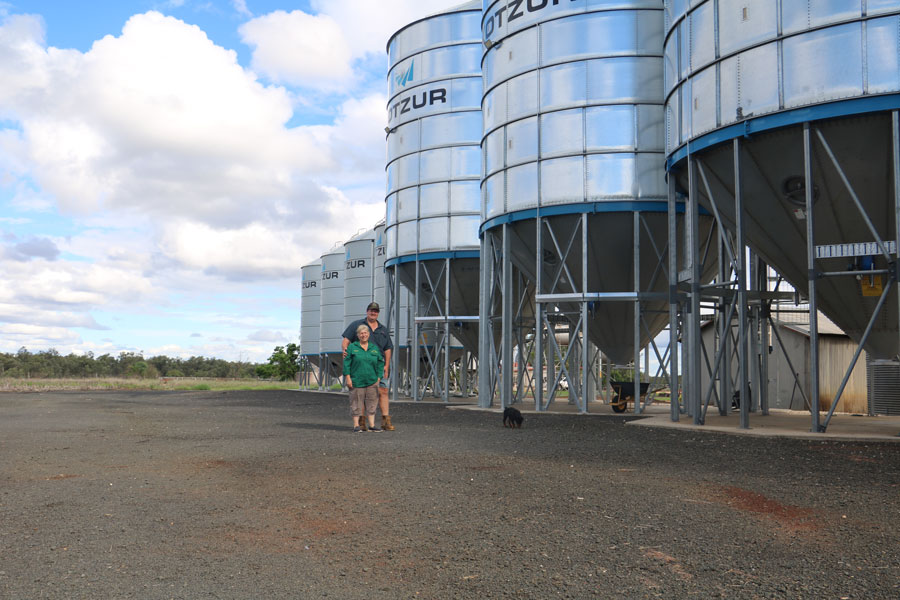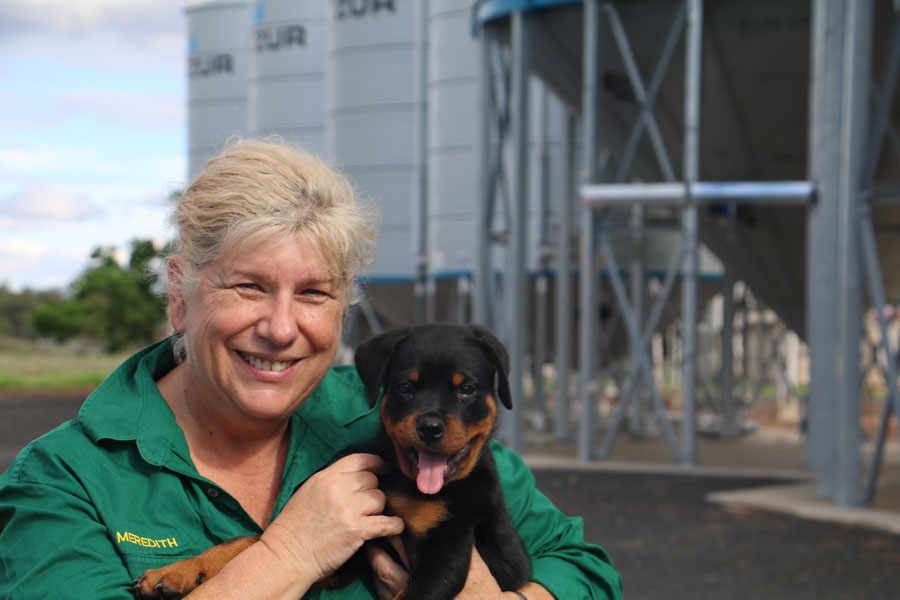Key points
Growers: Gordon, Meredith and Rohan Staal
Location: Emembi Downs, near Emerald in Central Queensland
Property size: 2000 hectares across two farms, 50 kilometres apart
Average annual rainfall: 600 millimetres
Soil types: On the home farm, shallow black downs soils. On the river property, floodplain soils
Cropping program: wheat, chickpeas and sorghum
In the past few years, the Staals have continued to improve on-farm storage across their two properties. They have built two silo complexes with 3000 tonnes of storage on their home farm at Emembi Downs and another 1500t at their Comet River farm.
Gordon and Meredith and their son and business partner Rohan farm 2000 hectares near Emerald, operating a wheat, chickpea and sorghum rotation.
Meredith says the silo complexes are an essential investment to ensure timely and efficient harvests. The plan is to keep adding to them over the next few years.
With the closure of many local grain receival depots, the move into on-farm storage makes sense.
A bumper local harvest in 2022 meant facilities just up the road at Gindie were reopened. Gordon says the ageing facility was quickly filled. “Our silos were essential for a timely harvest,” Meredith says.
Additionally, if that facility is closed, grain must be hauled to Yamala. “That’s about 50 kilometres away from the home farm. And on the other property, the road network is just not there. We can cut across the black soils if it’s dry, but if not, it is a 90km haul.”
This distance is also reflected in freight costs – up to $25 a tonne. “On-farm storage also gives us opportunities. We are not pressed to sell at harvest and can chase other markets. Or, if we have quality issues, we can find a home for that grain later. The capacity to dry grain also creates efficient harvest opportunities to get the grain off and bring moisture levels down if we need to,” she says.
Efficiencies and timeliness have also seen the Staals invest in a 36.5-metre belt conveyor that can unload a semi-trailer in five minutes without any loss in product quality.
Nutrient plans
On-farm innovation and changing industry parameters have also meant altering nutrient practices.
Being involved with the Northern Farming Systems research project means Gordon has seen first-hand the results from several experimental systems.
This GRDC-supported project is run locally by the Queensland Department of Agriculture and Fisheries (DAF) and includes a high-fertility system that utilises manure. Gordon saw the benefits of this and began putting down 10 tonnes per hectare of manure four years ago.
“We’re getting pretty good results, but it is really about the ongoing cumulative effect. It’s all about getting microbes active,” he says.

Meredith and Gordon Staal say investments in storage are essential to ensure timely and efficient harvests. Photo: Rebecca Thyer
Manure is hard to get in Central Queensland and Gordon sources his from a feedlot 60km away. “There are not a lot of feedlots around here and the ones that are here often use the manure themselves. So far, the biggest cost is freight.
“Logistically, we can’t put more down at a time than 10t/ha. So, we are doing that to each paddock every four to five years.”
He tends to buy 2000t of manure at a time and says storing it is not a problem. “The longer you leave it the more it composts and softens up, so we can store it for a while.”
Spreading manure with a 20t GT Bunning Spreader is a dry-weather job. “Ideally, we do it straight after a dry winter harvest when the ground is cracked open and then follow-up rain incorporates it into the profile.”
Manure is not the only change to his nutrient management plan of late.
Company shake-ups in the fertiliser world have seen the loss of anhydrous ammonia as a nitrogen source. It has meant a move to the liquid fertiliser UAN (urea ammonium nitrate).
“We’ve used anhydrous ammonia for 50 years here. But we’ve had to move to UAN because anhydrous ammonia is not being made available anymore. It is half the strength of anhydrous ammonia, so we need to buy more in volume. So, again, freight is a big component.”
The change has also meant machinery and application changes. In 2022 Gordon used the boomspray to stream it. He will look at a disc soil applicator in the future to allow zero-till pre-application.
Pulses
The Northern Farming Systems project is also experimenting with pulses and, although keen to keep abreast of the work, Gordon is already a chickpea fan.
“They are my absolute favourite and 2023 proved to be a good year for them. We had a full profile and excellent wheat stubble and the chickpeas excelled. They yielded 2.6t/ha and – on heavier soils – 3t/ha.
“With their long coleoptile length, you can deep sow them in a dry year. That’s what I love about them. If you have the gear to deep sow, you can get a germination and when rain does come it is in-crop.”

Meredith and Gordon have invested in a furry friend, Barney, pictured here with Meredith. Photo: Rebecca Thyer
Gordon had his best chickpea crop eight years ago, yielding 3.5t/ha. It prompted an investment in a parallelogram planter. Its hydraulic downforce allows deep sowing. “In a dry year, you can get down 10 inches (250 millimetres) to 12 inches (300mm) and still achieve good crop establishment.”
Gordon estimates the soils on the Comet River block are 24-metre-deep alluvial floodplain soils.
Those deep soils got a drenching in November 2023 – the first rain since the beginning of July. It helped some later-planted wheat and chickpeas. “The early wheat yielded 2.5t/ha; the later wheat did 20 per cent better when growing conditions were perfect.”
Although Gordon loves chickpeas, he is not quite so fond of mungbeans. “You need early in-crop rain to make them work and we had puffy pod syndrome (phytoplasma symptoms), which meant a 20 per cent yield drop. I would prefer to fallow the paddocks a little longer and grow chickpeas.”
The next job was to get the sorghum crop in. The Staals planned to plant 160ha in late January. “We’ve had great rain in November and December, but January started a bit dry with only patchy storms.”
The Staals are also hosting the sorghum National Variety Trials this year.
More information: Gordon Staal, staalgm@gmail.com

























































